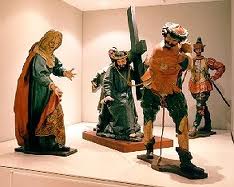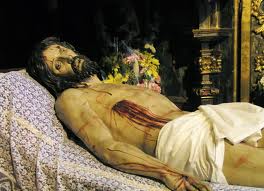Baroque: Gregorio Fernández
Gregorio Fernández was a Spanish sculptor who worked primarily in the Baroque style. He was one of the key members of the Castillian School of Baroque sculpture which included other famous Spanish sculptors like Alonso Berruguete and Juan de Juni.
Gregorio Fernández (1576-1636)
Gregorio Fernández was born in Sarria in the Spanish region of Galicia. Later in life, Fernández travelled to live in the city of Valladolid from 1601 until 1606 in order to work for the Spanish Royal Court.

Gregorio Fernández trained with Francisco del Rincón, after which he received many commissions from members of the upper Spanish classes such as the Duke of Lerma, various Counts of Fuensaldaña, and even royalty, as Fernández received commissions from the Spanish King, King Philip III.
Gregorio Fernández originally began working as an assistant with other artists in their workshops. However after he had built up a sufficient client base he set up his own workshop. From here he took on many apprentices and expanded his business until he had workshops in numerous Spanish cities.
While in Valladolid, Gregorio Fernández dedicated some of his time studying the works of other Spanish sculptors such as Juan de Juni and Pompeo Leoni. This helped Fernández to acquire an elegant yet academic style of sculpting just like Juan de Juni used in his early sculptures. Gregorio Fernández also learnt to convey drama in his religious scenes, yet he did so with a much more naturalistic style than his contemporaries.
However, Fernández's style changed over the course of his life. It began as Mannerism yet evolved into a Naturalistic Baroque style. Gregorio Fernández adapted his work to fit in with the strong Counter-Reformation movement by using a Realistic style which represented the current attitude towards religion at the time.
Gregorio Fernández's sculptures tended to be made of wood and then polychromed in bright colours so as to keep the audience's attention focused on the subject being portrayed. The realistic style was achieved by showing realistic features such as tension in muscles of the figures and the softness of the skin. In order to make his sculptures even more realistic, Gregorio Fernández would use eyes made of glass and teeth made from ivory. The subjects of his sculptures tended to be calm figures yet in a dramatic style.

Among his many sculptures, Gregorio Fernández produced some procession pieces. These sculptures were designed to be used in the many religious processions that exist in Spain today. Some of his processional sculptures include 'Tengo sed' (I am thirsty), 'Camino del Calvario' (Ride of the Cavalry) and 'Descendimiento' (Descent).
One of his most famous works is 'La Piedad con los dos Ladrones' (Piety with Two Thieves) which Fernández produced in 1616 for the 'Cofradía de Ntra. Sra. de las Angustias de Valladolid' (Guild of Our Lady of Sorrows of Valladolid). The central group of figures in this work include the Virgin Mary and Jesus Christ, both are sculpted with extreme attention to detail. The two thieves in the piece also have wonderful accurately sculpted bodies, anatomically speaking.
Many of his stand alone pieces achieved great success in the Baroque period. Some of his favourite themes included the life of Christ. He produced many images of Christ including 'Cristo de la Flagelación' (Scourging of Christ), 'el Crucificado' (The Crucifixion) and 'Cristo yacente' (Christ lying).
'Cristo yacente' (Christ lying) represents a dead Christ lying on a shroud. The body of Christ is extremely realistic and naturalistic, showing all the pain and emotion of the figure effectively. The realistic quality of the sculpture if enhanced by the use of ivory teeth, glass eyes and nails made from the horn of an animal.
Gregorio Fernández was a deeply influential artist from the Baroque period. He influenced many other artists, even after his death. Fernández's sculptures of Christ and particularly of Christ lying down, served as models for subsequent artists. His many apprentices and students continued his work as well, although no particularly well known artists came from his set of disciples.
